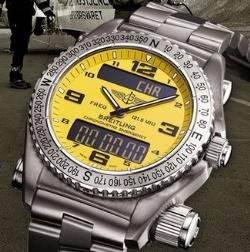 Steve Fossett wears a Breitling Emergency wristwatch. As you can see, it’s a good-looking multifunction analog/digital. It’s also got Breitling’s temperature-compensated Superquartz movement, so it’s highly accurate.
Steve Fossett wears a Breitling Emergency wristwatch. As you can see, it’s a good-looking multifunction analog/digital. It’s also got Breitling’s temperature-compensated Superquartz movement, so it’s highly accurate.
What makes it really special, though, is that it contains an emergency transmitter. The wearer can unscrew and extend the antenna (the large knob near the lower right lug), and transmit on 121.5 MHz (an aviation emergency frequency) for 48 hours. The transmission will go 100 miles or so in ideal conditions, but half of that is a slam-dunk under any conditions. It also has a separate battery from the one powering the movement.
Fossett hasn’t activated that watch. And it’s been long enough now that he’d be past hesitating on the basis of not bothering anyone needlessly, or some similar reason.
I hope he’s all right. He’s a hero, and we need heroes. Unfortunately, heroes sometimes die pursuing the very activities that define them. I fear that’s what has happened.
Thanks to gadgetreporter.com for the Breitling image.
You might also like:
- Lessons from a little boy’s wristwatch
My sons are seven and almost ten, and they each have and wear a wristwatch. Aaron just got his; Nath… - Steve Spurrier resigns
I was 19 years old when Steve Spurrier starting coaching Florida. I thought he must be the most arro… - Only the government can save us from the rich people
Oh, and I am the 99%. Or something. Is anybody in this “Occupy” “movement” saying anything that does… - I heard a click; I think he reloaded
I turned on my radio scanner one night, and that was the first thing I heard. It was an excellent ex… - Casio produces the best geek watch yet
I’ve had my Casio PAW-1300, previously briefly discussed in this post, for about a month now. Price …

I seem to be out of a loop here – is the guy missing?
Yes, he flew off from an airport in Nevada several days ago and has not been heard from since.
My understanding is that he owns and usually wears the watch but that he happened not to have worn it this trip.
No signal detected by satellite or search planes on 121.5 or 243 MHz from the Crash Position Indicator but such devices often fail to activate on impact or are destroyed by crash forces. Water and terrain could easily block such signals anyway.
Soon only digial EPIRB signals on 406MHz will be acted on by satellites.